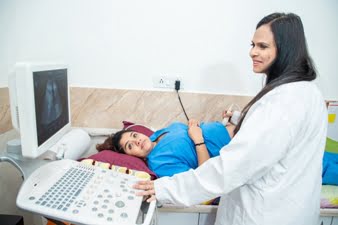Why is USG Bilateral Lower Limb Arterial Doppler Important?
A USG Bilateral Lower Limb Arterial Doppler is essential for diagnosing and managing conditions that impact blood circulation in the legs. At Diagnopein, the best sonography centre near you in Pune, this test is conducted with precision and care. Key reasons for its importance include:
1. Diagnosis of Peripheral Artery Disease (PAD): One of the primary uses of Bilateral Lower Limb Arterial Doppler is to diagnose Peripheral Artery Disease (PAD). PAD is a condition where the arteries in the legs become narrowed or blocked due to the buildup of fatty deposits (atherosclerosis), restricting blood flow. This can lead to symptoms like pain or cramping in the legs, particularly during physical activity. The Doppler ultrasound can detect areas of restricted blood flow, helping doctors assess the severity of PAD.
2. Evaluation of Blood Flow in the Legs: The Doppler ultrasound assesses the speed and direction of blood flow through the arteries of the lower limbs. This is important for detecting any irregularities or disturbances in the blood flow, such as narrowing or blockages that can affect circulation.
3. Detection of Aneurysms: The test can identify the presence of arterial aneurysms in the lower limbs. Aneurysms are abnormal bulges or weak spots in the arterial walls that can lead to dangerous complications if they rupture. Doppler ultrasound helps assess the size, location, and potential risks associated with these aneurysms.
4. Identification of Blood Clots: Blood clots (thrombosis) in the arteries can also be detected using this technique. Arterial thrombosis can block blood flow to the affected limb and, if left untreated, lead to tissue damage. Doppler ultrasound helps locate blood clots and evaluate the extent of the blockage.
5. Pre-Surgical Evaluation: For patients undergoing vascular surgery, such as bypass surgery or angioplasty, the Doppler ultrasound is used to evaluate the condition of the arteries in the legs before the procedure. It helps surgeons understand the level of blockage or narrowing, guiding their approach during surgery.
6Monitoring Post-Treatment or Surgery: After treatments like angioplasty, stenting, or vascular surgery, follow-up Doppler ultrasounds can monitor the success of the procedure and check for complications such as restenosis (re-narrowing of the artery).
How is USG Bilateral Lower Limb Arterial Doppler Performed?
1. Preparation: There is typically no special preparation required for this test. However, you may be asked to wear loose, comfortable clothing so that the technician can easily access your legs. You may also need to remove any jewelry or accessories that could interfere with the procedure. If you are on medications or have any pre-existing conditions that may affect the test, be sure to inform your healthcare provider.
2. Procedure: During the procedure, you will lie down on an examination table. The technician will apply a gel to the skin of your legs to ensure that the ultrasound probe makes good contact with your skin and can transmit sound waves effectively. The ultrasound probe (transducer) is gently moved over the surface of both legs, and it emits high-frequency sound waves that bounce off the blood cells moving through the arteries. The sound waves are then translated into real-time images and Doppler readings, showing the direction and speed of blood flow. The technician will examine the arteries in both legs, from the thighs down to the ankles, looking for any areas of narrowing, blockages, or other abnormalities.
3. Duration: The procedure usually takes between 30 to 45 minutes, depending on the complexity of the examination and the number of arteries being assessed.
4. Post-Procedure: Once the procedure is completed, the gel is wiped off, and you can resume normal activities immediately. There is no recovery time or special aftercare needed following the test.
Who Should Consider a USG Bilateral Lower Limb Arterial Doppler?
The USG Bilateral Lower Limb Arterial Doppler is particularly recommended for individuals with risk factors or symptoms related to vascular diseases in the legs. Some groups of people who may benefit from this test include:
1. Individuals with Symptoms of PAD: People experiencing leg pain, cramping, or numbness, particularly during walking or exercise (called claudication), may have PAD. A Doppler ultrasound can assess the extent of the condition and determine the need for treatment.
2. People with Risk Factors for Atherosclerosis: Those with diabetes, high blood pressure, high cholesterol, or a family history of cardiovascular diseases are at higher risk of developing arterial blockages or narrowing. These individuals may be advised to undergo regular Doppler ultrasound examinations to monitor their vascular health.
3. Patients with Known or Suspected Blood Clots: If you experience swelling, redness, or pain in your legs, or if you have a history of deep vein thrombosis (DVT) or arterial thrombosis, a Doppler ultrasound can help identify any current clots or areas of concern.
4. Individuals Preparing for or Recovering from Vascular Surgery: Patients planning vascular procedures like angioplasty, stent placement, or bypass surgery may need a Doppler ultrasound to evaluate their vascular condition beforehand. It can also be used to monitor recovery after surgery to ensure that the arteries are functioning correctly and that there are no complications.









